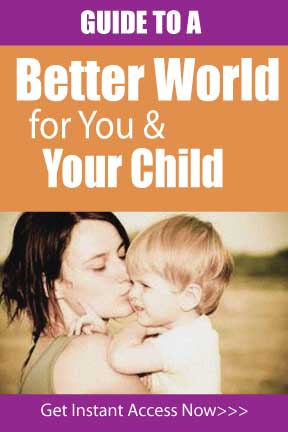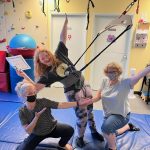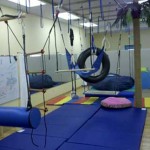Here at Ohana OT we serve over 100 children per week with sensory processing disorders. Most of these children have a hard time changing and transitioning to a new activity or place often resulting in a meltdown. Transitions are challenging for them because all the sensory input changes with each transition and they have a great deal of difficulty habituating or adapting to the changing stimuli (visual, auditory, tactile, movement, smells etc). Think of when you are in an unfamiliar place and how much energy it takes to adapt and get used to it. Nothing is on automatic pilot from where to reach to turn on lights to getting used to the odd sounds and smells. Once you are there for a day or two everything becomes natural and automatic, not effortful or distracting. Our children with sensory processing problems have great difficulty habituating or getting used to changes which can often result in behavior problems and meltdowns. The great news is that there are many things we have found that are very effective in making transitions less stressful for our sensational kids!
We find transitions work best when it’s not the adult telling the child what to do. For example when it is time to end our therapy sessions the transition work best when there is a transition object that initiates it (such as a visual timer), then the transfer of blame is placed on the timer telling the child “all done” and not on the adult telling the child about time. I like to have the child take responsibility (even non verbal children with Autism) by saying “How are we doing on time – is there time for one more thing?” It is amazing how much they are able to manage the transition themselves when there is a tool to do so.
Here are our favorite TOP 6 Transition Tools:
1) VISUAL transition tools
- Visual Timer- we use these two visual timers all the time. The first one is the Time Timer and it is available in 3 sizes on Amazon. The largest size has the most audible beep.

- We also use a free app on our phones called the Children’s Countdown Timer. It has a variety of pictures you can use to reveal and you can customize with any photo you want to use such as the next activity.

- Visual Schedule (e.g. schedule of all activities to know when all done will occur).

- Visual Checklist (e.g. what do to list when its time to go)
- First, Then visual. This is two boxes (“first” and “then”) with only two activity cards showing them what they are doing now and next.
2) TACTILE transition tools
It is amazing to see the magic of something to hold in the hands that has to be taken from one spot to the other. It can be as simple as a post it note from one teacher that says “hi” to the other teacher. Children respond really well to having a delivery job to do. There is also something about having a consistent object with them from one environment to the other (such as a plastic animal to hold onto). Another example would be to give them a book to put on a shelf in the room you want them to move to “put the book on the shelf”.
3) AUDITORY transition tools
Songs are wonderful ways to help children transition. For example the “clean up song” and the “goodbye song”. Auditory timers work well too. Even a simple kitchen timer is great. See also the visual timers above. The countdown app has some fun and exciting sounds to choose from.
4) COGNITIVE transition tools
- First, Then language (e.g. prep with verbal 5 minute warning, then 3 minute warning, 1 minute warning)
- Develop a transition mantra “when the timer goes beep beep, it’s clean up” or “when the timer goes beep beep, be nice to mom and put on shoes”. Ask child through the day “what happens when timer beeps” in order to prepare them for the transition.
5) KINESTHETIC/ Physical Position transition tools
- Do the last activity in a transition room (e.g. lobby, front porch, near door, etc.)
- Make it fun, “How fast can you put on your shoes?” and time them ,”Oh no, the door is closing, will you make it???” or “WOW look what over here”. Pretend to be Momma Duck, and the kid is Baby Duck, and they have to follow you. quack quack.
6) ROUTINE / Predictability transition tools
- Practice using 1 transition technique, so the child gets into a routine, routines give us predictability. It must be consistent. Routine transitions are easy, unplanned routines are tricky.
- Create a social stories on what will happen next. A social story is a simple book with pictures that explains step by step what to expect.
- Show video on what will happen such as going to a new place.
Let us know if this article was helpful at marykostka@ohanacenter.com
There are two other articles in this series:
Blog Article: Sensory Smart Classroom Secrets Part 1 – Classroom Environment covers changes to the classroom environment to make it more sensory friendly and Blog Article: Sensory Smart Classroom Secrets Part 2 – Calming the Student’s Body covers how to provide the body with calming sensory input in the classroom.
Next Step:
If you need additional help contact us at (509) 888-7435 or at marykostka@ohanacenter.com to set up a Skype consultation and pay here.
Mary Kostka is a Pediatric Occupational Therapist specializing in Sensory Processing Disorders at her private practice, ‘Ohana Occupational Therapy, LLC, in Wenatchee and Leavenworth Washington, USA She has over 29 years of experience with assisting teachers with making their classrooms sensory friendly.
OhanaOt.com
‘Ohana Occupational Therapy, LLC
1139 N Princeton Suite B
Wenatchee, WA 98801
Ph: 509-888-7435
Fax: 509-888-7674







Leave a Reply
You must be logged in to post a comment.